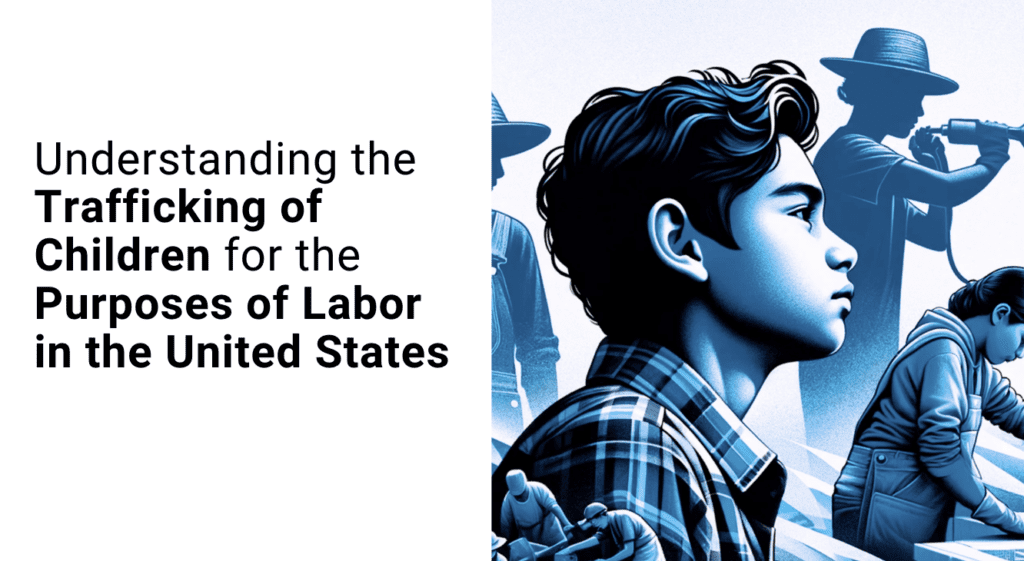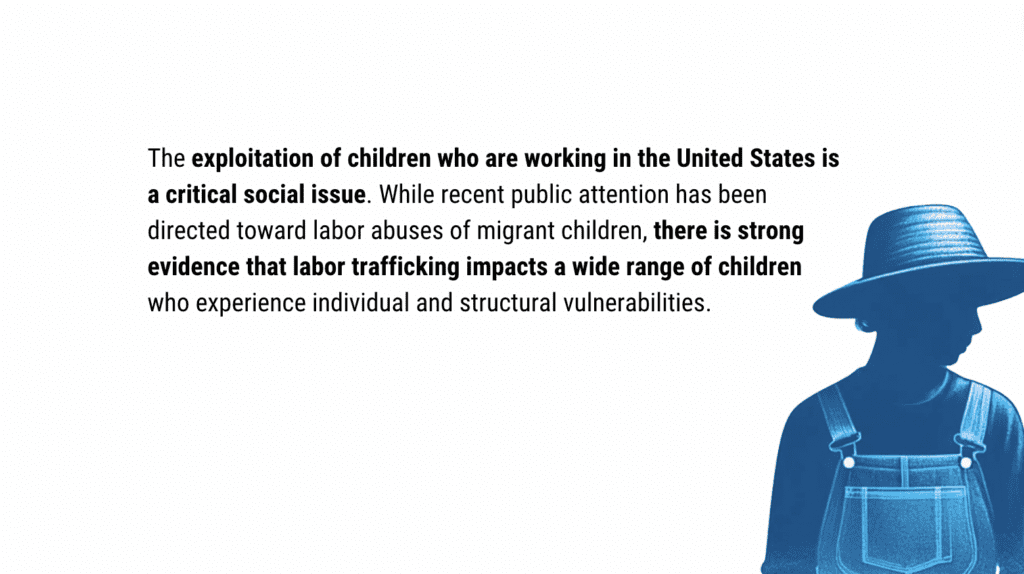A new study co-authored by Amy Farrell, Director of the School of Criminology and Criminal Justice at Northeastern, provides valuable insight into the victims and perpetrators of child labor trafficking. A largely misunderstood phenomenon, child labor trafficking affects a wide range of children, including U.S. and foreign-born children, in a variety of industries from agriculture to domestic work.

Supported by the National Institute of Justice, the study titled “Understanding the Trafficking of Children for the Purposes of Labor in the United States,” explored how a lack of understanding around victims, and the complex circumstances that ensnare children in these situations, is contributing to an inadequate response by first responders. In the context of this study first responders included police, immigration officials, schools, child welfare systems, juvenile justice systems or labor inspectors.

The report showed that most first responders who engage with children are not identifying child labor trafficking cases or misidentifying child labor trafficking cases. Farrell and the other report authors including Meredith Dank, New York University, Katherine Kaufka Walts, Loyola School of Law, Callie Hansson, Northeastern University, Andrea Hughes, New York University, and Chlece Neal, Loyola School of Law, are hopeful this new research will fill in the gaps, helping first responders more accurately and effectively identify instances of child labor trafficking.
This study is the first comprehensive examination of child labor trafficking in the U.S. and provides detailed information about the nature of child labor trafficking. Key findings included:
- Researchers found that of the cases they examined U.S. citizens (42%) and foreign nationals (58%).
- Male (38%) and female (59%) victims were identified, average age of 14.
- Undocumented foreign national children were particularly vulnerable to labor trafficking.
- Lack of safe, affordable housing alternatives consistently identified as a barrier to leaving the trafficking situation.
- Perpetrators, predominantly in their 20s and 30s, played diverse roles in the exploitation process.
- Recruiters were commonly known to the victim
- biological parents (29%),
- other family members (11%)
- acquaintances (285)
- While there is no dominant profile of perpetrators, many were individuals, families, and “organized” non-criminal groups, such as cult or spiritual leaders and sports team leaders.
- The prevalence of child labor trafficking victims who experience exploitative labor practices (97%), fraud (91%), coercion (97%), and/or threats or physical violence (95%).
- An average of 16 different domains of harm were experienced by victims for each trafficking case.
- The distinction between labor exploitation and labor trafficking is often non-existent in cases involving children, as “coercion” in labor trafficking is inherent in the power dynamics of relationships between adults and children.
- Forced criminality is a form of labor trafficking experienced by many children, yet most children experiencing such victimization are misidentified as perpetrators of crimes as opposed to victims.
- Most first responders who engage with children, including child welfare agencies, law enforcement, labor investigators, and even schools, are not identifying child labor trafficking cases.
- Only 15% of the cases were identified by law enforcement.
- Approximately 45% of victims demonstrated remarkable resilience by escaping the victimization situation or seeking help independently. In some cases, when they sought help, assistance was denied due to characterization of the trafficking as a “family problem” or “labor issue” versus the crime of labor trafficking.
Working is a fundamentally important part of a young person’s development, but when that work is abusive, coercive, or harmful there are long term consequences for young people, their families, and their communities,” said Farrell. “We are hopeful that the solutions we recommend will fundamentally improve the conditions under which young people work, learn, and grow.”
Within the study Farrell and the team provided several recommendations:
- Harmonize state legislation with federal anti-trafficking laws to ensure laws and policies protecting child sex trafficking survivors also include child labor trafficking survivors.
- Provide additional training to all stakeholders engaging with children on child labor trafficking, including education/schools, law enforcement, immigration officials, child welfare systems, juvenile justice systems and labor inspectors.
- Operationalize screening and services for victims of child labor trafficking on par with child sex trafficking.
- Consider recognizing all cases of child labor exploitation as a form of child labor trafficking, particularly given the limited capacity children have to distinguish between coercive or compelled work versus voluntary work.
- Explore opportunities to expand vocational programs to provide valuable skills while offering safe, lawful employment opportunities for children.
- Create safe, rapid, subsidized alternative housing options for minors, regardless of immigration status.
- Explore opportunities for temporary legal protections for noncitizen children to minimize their unique vulnerabilities to predatory labor exploitation and make them eligible to engage in existing vocational and job readiness programs for youth and young adults.
- Expand post-release services and support to non-citizen children released from federal custody into US communities living with sponsors to ensure children and family are receiving the support they need.
- Collaboration with immigration attorneys and law school clinics to provide comprehensive legal assistance to foreign national minors within schools, including work authorization, visa applications, and expungement.
- Enhance penalties for civil violations of child labor laws and child labor exploitation to ensure consistency in protections across state and federal laws.
Child labor trafficking is multilayered and more difficult to identify than adult trafficking cases because of a child’s unique vulnerabilities. Children rely on adults for basic needs, altering the definition of ‘coercion,’ that categorizes labor trafficking. The solutions to this nuanced and complex issue rely on the collaborative and interdisciplinary work of law enforcement, researchers, and educational institutions.
To learn more view the full report.




